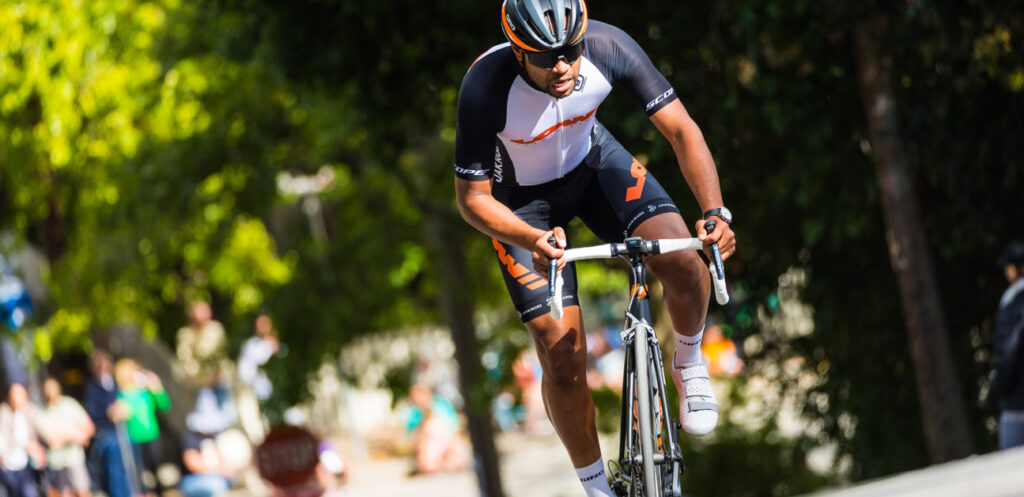Cycling Sprint Workouts: How to Improve Your Maximum Sprint Power

Peak sprint power is a combination of fitness and technique. Just because you wouldn’t label yourself as a sprinter, doesn’t mean you can’t have a powerful snap. With the right combination of cycling sprint workouts and drills, you can increase your peak sprint power.
For more information on sprint training, check out Ask a Cycling Coach Ep 262.
Sprint is a unique cycling skill as it relies just as much on fitness as it does a proper technique. On the fitness end, you’ll be using all three energy systems but typically sprinting the job of the neuromuscular system. Also called the phosphocreatine energy system, it uses stored ATP and creatine phosphate (ATP-PC) for maximum efforts lasting less than fifteen seconds.
Adaptive Training
Get the right workout, every time with training that adapts to you.
Check Out TrainerRoadThe problem is that rest or low intensity is required for the neuromuscular energy system to recharge, so peak sprint power reduces with repeated sprints. This is why cyclists try to protect their sprint, saving it for the most decisive moment. However, recent research suggests that aerobic fitness can influence the rate of recovery.
What is Peak Power Output
Peak Power Output is more than just pushing hard on the pedals. Yes, the amount of torque applied to the pedals is important, but cadence is another critical component of power. Simply put, power is torque x cadence.
To increase your peak power output, you’ll need to train the amount of torque and your rate of cadence change. In terms of sprint power, it’s helpful to think of torque as how you recruit all your available fast-twitch muscle fibers and cadence as the speed that you apply it. The good news for anyone who wants to increase their maximum sprint power is that both of these things are highly trainable.
Benefits of Sprint Workouts
Training the neuromuscular system for maximum sprint power is different from training the aerobic or anaerobic energy systems. The reason for the difference is that the neuromuscular energy system is the least adaptable of the three. Does that mean there’s not any benefit for sprint workouts? There’s plenty to be gained from cycling sprint intervals.
Foremost, sprint workouts help you establish and strengthen your neuromuscular pathways, which leads to increased coordination. In turn, your technique will improve. Additionally, these types of workouts can increase your anaerobic capacity and repeatability.
Cycling Sprint Workouts
Cycling sprint intervals come in all shapes and sizes, but the primary objective is to increase muscle fiber recruitment. These sprint workouts are not for full power, all-out efforts where you are rocking the bike as hard as you can. It’s best to complete those outside to avoid damaging your frame or trainer.
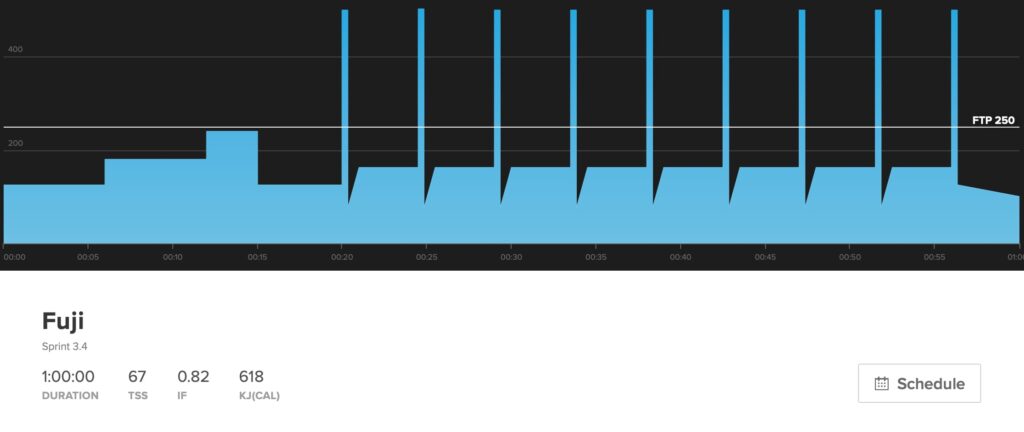
Fuji is 9×20-second all-out efforts at 200% FTP, each separated by about 4 minutes of active recovery at 65% of FTP. The primary aim is to increase the amount of force you can apply to the pedals. In between these cycling sprint intervals, you’ll accumulate a fair amount of aerobic endurance riding.
By effectively increasing your ability to drive the pedals, one-half of the strength-endurance combination is satisfied, paving the way for higher power during short efforts and a higher FTP due to greater muscular capabilities.
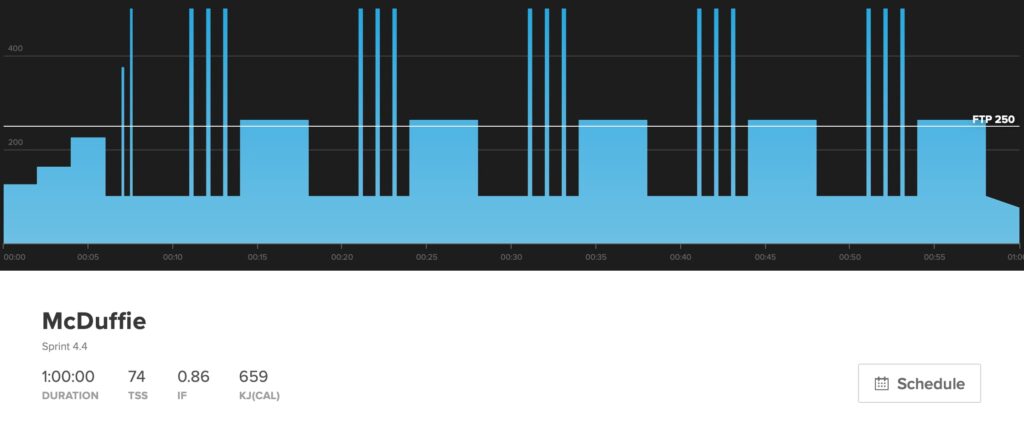
McDuffie consists of 5 sets of sprint intervals, comprised of 3×12-second sprints at 200% FTP followed closely by a slightly suprathreshold, 4-minute effort at 105% FTP. Recoveries between sprints are about 50 seconds long, and the recoveries between sets are 3 minutes each.
This workout’s primary objective is to increase muscle fiber recruitment via all-out sprint efforts and reap the reward of this additional muscle activity to power through a demanding, leg-searing 4 minutes of work slightly above Functional Threshold Power (FTP).
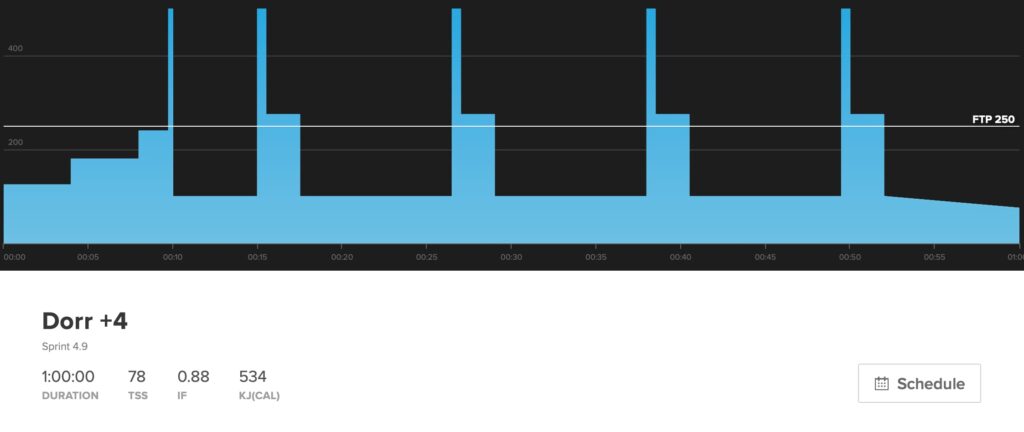
Dorr +4 is 4×30-second hard starts way up at 200% FTP followed by 2 minutes of suprathreshold work at 110% FTP. Nine minutes of recovery falls between each effort.
This sprint workout offers a few chances to test and fine-tune your initial acceleration capabilities. Go out too hard and risk blowing up; go out too softly and risk losing position. Still, if you use these repetitions to learn the sort of efforts, you can perform at the start of a race, and perhaps more importantly, repeat during later stages of a race, you’ll stand a far greater chance of not only surviving these hard kicks but making them work for you.
Strength Training Workouts to Improve Your Sprint
One of the more significant ways to improve your sprint power is using strength training. The only way to increase ATP-PC stores is to increase muscle mass or supplement with creatine. Adding in some resistance training can help you add muscle mass if you need to. Additionally, strength training will increase the amount of muscles fibers you recruit and how forceful they contract.
There are three different approaches to strength training workouts to improve your sprint power. The first is the classic use of heavy weights. This would include lifts like the squat or deadlift for 3-5 reps in 3-5 sets at 85-95% of your one-rep maximum. You can do this 2-3 times per week. Another form of strength training is plyometric exercises. These are explosive bodyweight movements. The classic box jump is a great example. However, if you are new to plyometric exercises, start slow until you have mastered the movements to avoid injury.
Finally, you can combine traditional strength training with plyometrics. Ballistic training adds light weights to explosive movement. A good place to start is with jump squats. Use 30% of your one-rep max and focus on the velocity at which you can lift the load.
Sprinting uses muscles throughout your body, so a well-rounded regimen is recommended. Of course, you’ll want to target the lower body. But the upper body and core strength are just as important. Below is a sample of two days per week of strength training workouts to improve your sprint. If you’re new to weight training, remember to take it slow. For more on how to get started with strength training, check out Strength Training Basics for Cyclists.
Day 1
| Exercise | Sets | Reps |
| Squats | 3 | 5 |
| Bench Press | 3 | 5 |
| Military Press | 3 | 5 |
| Planks | 3 | 30 sec.- 2min. |
Day 2
| Exercise | Sets | Reps |
| Deadlift | 3 | 5 |
| Barbell Row | 3 | 5 |
| Pull-ups | 3 | 5 |
| Planking Row | 3 | 10 (each side) |
Sprint Technique Drills
Once you’ve built the fitness and strenght for sprinting, it’s time to practice your sprinting technique. You can increase maximum sprint power by improving your cadence and torque. Here are some drills that you can complete on any ride outdoors.
Training Cadence for Sprint Power
Developing your ability to apply torque quickly requires plenty of practice. When you practice rapid cadence changes, you establish and strengthen neuromuscular pathways, leading to increased coordination and effective torque application.
One of the best ways to practice on the bike is by completing jumps or form sprints. This low-power drill is simple to do. Just pick a mid-range to light gear and then wind your cadence up as quickly as possible. Your goal is to go from a normal cadence to your max cadence in as little time as possible and then hold it for about ten seconds. Practice them seating and standing.
Training Torque for Sprint Power
Training for peak torque is best done with strength training and drills on the bike. Strength training helps develop muscle capacity, while the drills will help you apply it to the pedals. High-force stomps are the best drill for applying your gym strength onto the bike. These standing-start sprints consist of slowly turning over a big gear as forcefully as possible to recruit as many muscle fibers as you can. Done from a near stop, pick the hardest gear you can turn over without exceeding 90rpm in 12 pedal strokes.
Aim for five stomp efforts during your ride. These should last 10-12 seconds, with plenty of rest in between. You can complete these drills sitting or standing. While standing, hold onto your handlebar drops and drive each foot down as hard as you can while retaining excellent form. When seated, try to stabilize any lateral movement.
Putting It All Together
Every cyclist has strengths and weaknesses. One of the best ways to discover yours is to take a look at your power curve. Your power curve shows the work you’ve done plotted against time. On the TrainerRoad Personal Records page, you can view your power PRs on three different levels. Let’s look at an example.
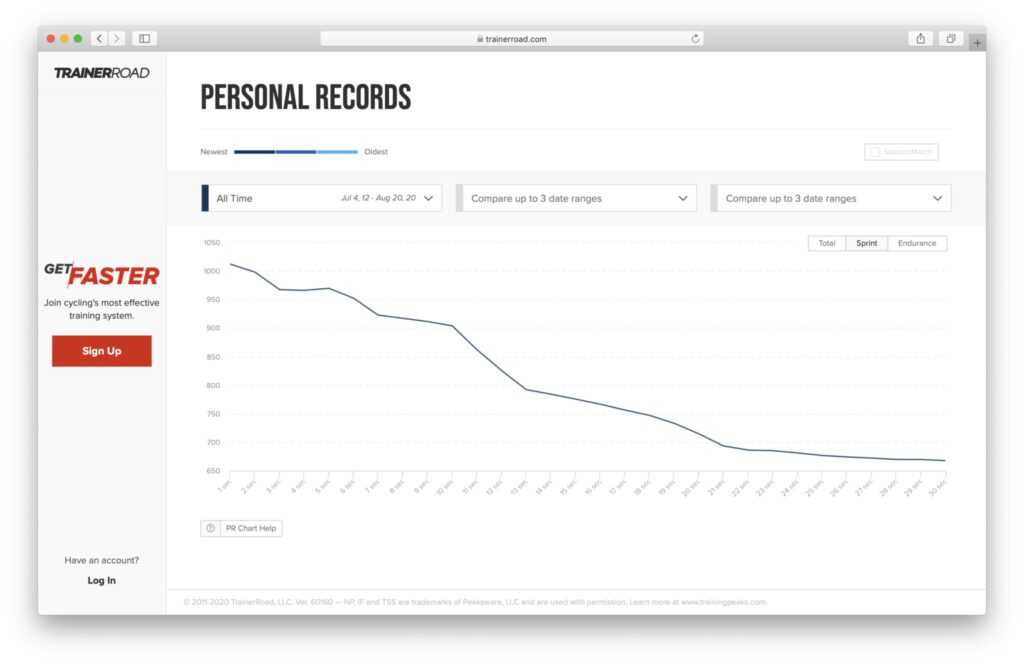
This example is of my colleague Nathan’s power curve set to the sprint level (1-30 seconds). His all-time peak one second power is just above 1000w and falls to about 900w at ten seconds. Typically when discussing peak sprint power, we look at the one-second mark. You can track your peak power easily from the Personal Records tab to track your progress.
Unleashing a great sprint is more than just power and acceleration. Body position and rhythm play a critical role. Sprint technique is something that requires consistent practice to master. And if you are racing against others, the right strategy is just as important. Here is a list of resources for improving your sprinting.
- Sprinting 101: How to Be Explosive
- Sprint Faster – Tips from a Pro
- How to Accelerate Past Someone in a Sprint
- Pro Tips for Sprinting When Your Breakaway Fails
- How to Find the Right Wheel in a Sprint
- How to Safely Fight for Position in the Final Laps of a Race
For more cycling training knowledge, listen to Ask a Cycling Coach — the only podcast dedicated to making you a faster cyclist. New episodes are released weekly.
